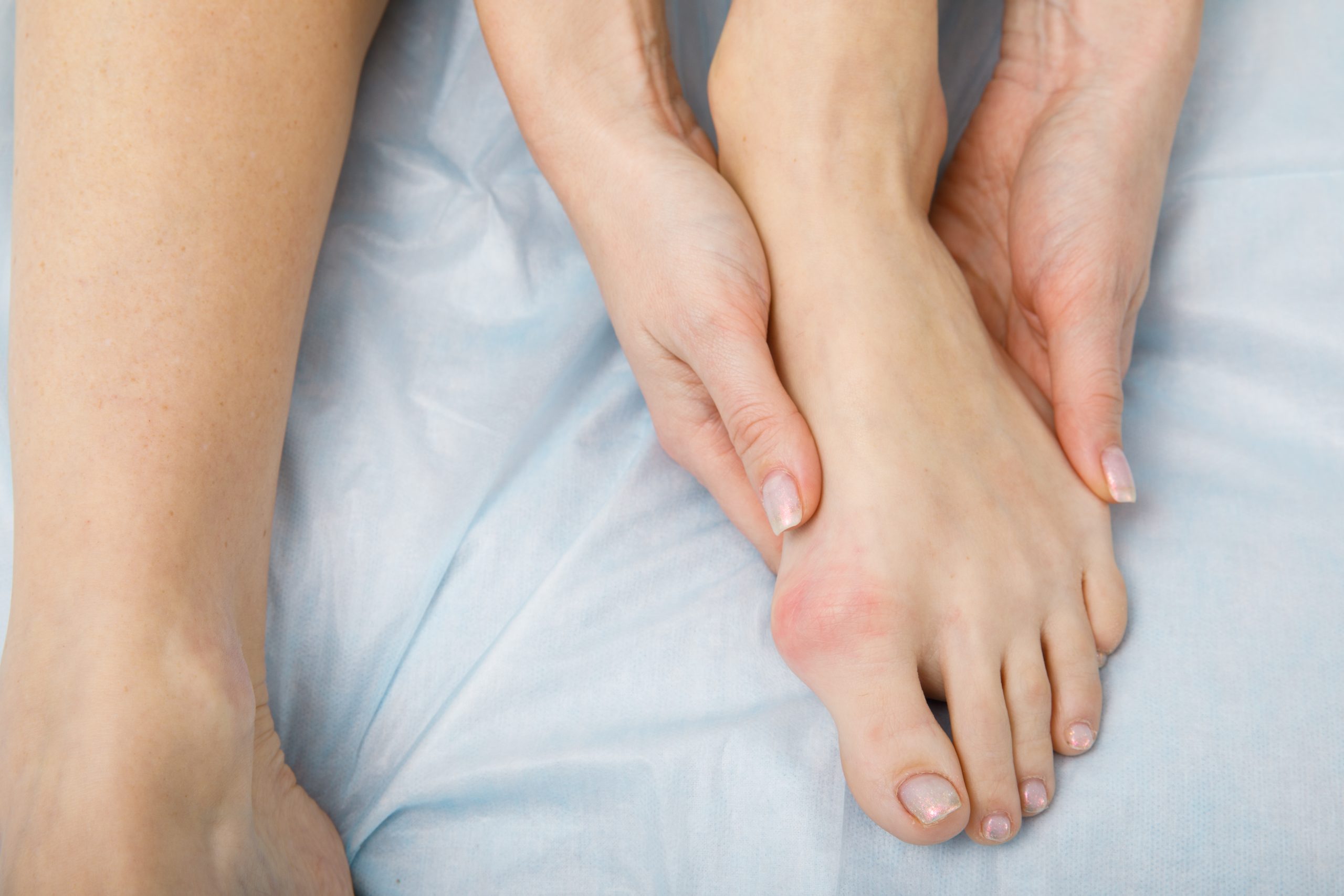
Bunions
The bunion, or hallux valgus, is a condition that affects the bones and joints associated with the great toe. It is one of the most common deformities of the forefoot. The condition develops slowly and results from the gradual dislocation of the joint, usually because of instability during gait. There is a displacement of the first metatarsal bone toward the mid-line of the body, and a simultaneous displacement of the great toe away from the mid-line (and toward the smaller toes). This causes a prominence of bone on the inside (medial) margin of the forefoot, this is termed a bunion. As the deformity progresses, the big toe will shift toward the outside of the foot. In severe cases, the big toe will actually overlap or under lap the second toe. It is often of a hereditary nature, but it is also associated with rheumatoid arthritis and other diseases. There are no exercises, splints or other devices that reliably correct a bunion. Orthotics can sometimes slow or halt the progression by addressing the instability which causes the deformity, but they cannot reduce the deformity.
Painful bunions decrease one’s ability to perform desired activities, and makes shoe fitting difficult. Surgery may be performed to correct the deformity.
Though a bunion is often described as a painful bump, this condition is much more complex than a simple bump on the side of the toe. X-rays show the true nature of the deformity and are used to help in the decision making process. Ranges of motion of joints associated with the toe are also performed to assess the deformity. There are many procedures for correcting a bunion and choosing the right one based on the examination increases the chance of success. The procedure performed on one person may not be the procedure required to give another a good result. In general, more severe bunion deformities require more extensive surgery and more extensive post-operative limitations. It is very important to note that the same instability and incorrect motion that causes a bunion also causes degeneration of the joint surfaces (osteoarthritis). Correction of the bunion cannot repair the damage done within the joint and continued pain from that separate process may occur. Realigning the joint may slow the damage within the joint and improve motion, but it may not alleviate all pain.
Complications of bunion surgery are not common, but include infection of soft tissue and/or bone, slow healing of skin or bone, irritation from fixation pins or screws, nerve entrapment, reaction to the foreign material (suture material, pins or screws), excessive swelling, excessive scarring, excessive stiffness (some stiffness is unavoidable), over-correction (hallux varus) and recurrence of the deformity. Rarely, some complications may require a second surgery to correct the problem. While these complications are rare, they should be weighed against the difficulty that you are experiencing to determine whether surgery is an acceptable risk for your condition. This is an important part of the process.
Overview of the bone anatomy of a bunion

Symptoms
- Redness, swelling, or pain along the inside margin of the foot just behind the great toe
- Moderate to severe discomfort at the bunion when wearing shoes, particularly if tight fitting .
- A painful callus may develop over the bunion
- Sometimes a painful corn on the adjacent sides of the first and second toes.
- Irritation if there is overlapping of the first and second toes.
- Arthritis may cause stiffness and discomfort in the joint between the great toe and the first metatarsal.
- There may be a fluid filled cyst or bursa between the skin and the “bunion bone”.
- Skin over the bunion may break down causing an ulceration, which can become infected.
Causes
- Abnormality in foot function, particularly a pronated foot. This is probably the most important and common causative factor.
- Family history of bunions.
- Narrow toed dress shoes and high heels may contribute to the formation of a bunion.
- Rheumatoid and Psoriatic arthritis.
- Genetic and neuromuscular disease (eg. Down’s,Ehler-Danlos and Marfan’s syndromes) resulting in muscle imbalance.
- Limb length inequality can cause a bunion on the longer limb.
- Generalized laxity of the ligaments.
- Trauma to or surgery on the soft tissue structures around the great toe (first metatarsal-phalangeal) joint.
What you can do
- Apply a commercial bunion pad around the bony prominence, use only non-medicated pads.
- Wear shoes with a wide and deep toe box. You should be able to “dimple” the leather over your bunion.
- Avoid all high heeled shoes.
- If your bunion becomes painful red, and swollen try elevating your foot and applying ice for about 20 minuets every hour.
- If symptoms persist, consult your podiatrist or physician .
What the doctor may do
- Apply special pads and dressings to protect the bunion from shoe pressure.
- Inject steroid and local anesthetic around the bunion to reduce inflammation. This is especially useful if there is an associated bursitis.
- Recommend commercially available or custom made shoes.
- Prescribe functional orthotics to correct faulty foot function, and help prevent worsening of the deformity.
- Recommend bunion surgery to correct the deformity.
Other causes of pain at the great toe joint
- Arthritis of the first metatarsal-phalangeal joint
- Injury to the soft tissue structures around the first metatarsal-phalangeal joint.
- Fracture of the great toe or first metatarsal.
- Tight shoes may cause pain at an otherwise normal joint.
- Sesamoiditis, this is an inflammation of one or both small bones which rest in tendons under the first metatarsal-phalangeal joint.
